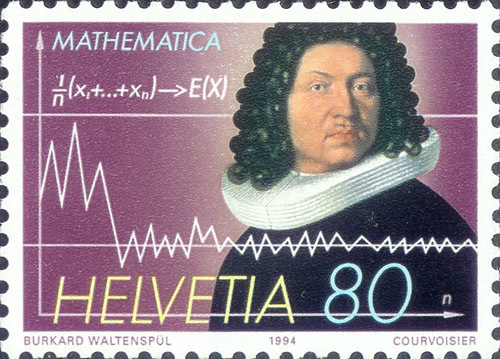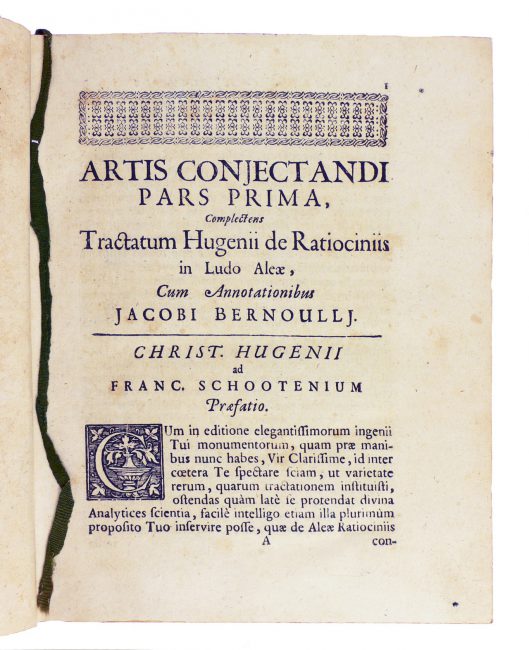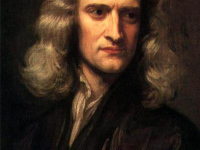
Jakob Bernoulli (1655-1705) on a Swiss stamp
On August 16, 1705, Swiss mathematician Jakob Bernoulli passed away. The Swiss Bernoulli family is well known for their many offsprings who gained prominent merits in mathematics and physics in the 18th century. Jakob Bernoulli, born in 1654 (or 1655 according to the new Gregorian calendar), is best known for his work Ars Conjectandi (The Art of Conjecture). In this work, published 8 years after his death in 1713 by his nephew Nicholas, Jakob Bernoulli described the known results in probability theory and in enumeration, including the application of probability theory to games of chance.
“[P]robability as a measurable degree of certainty; necessity and chance; moral versus mathematical expectation; a priori an a posteriori probability; expectation of winning when players are divided according to dexterity; regard of all available arguments, their valuation, and their calculable evaluation; law of large numbers…”
— Jacob I Bernoulli, Ars Conjectandi (1713)
The Bernoulli Family
The Bernoulli family of Basel was a patrician family, notable for having produced eight mathematically gifted academics who, among them, contributed substantially to the development of mathematics and physics during the early modern period. Originally from Antwerp, a branch of the family relocated to Basel in 1620. The first known member of the family was Leon Bernoulli (d. 1561), a doctor in Antwerp, at that time part of the Spanish Netherlands. His son, Jacob, emigrated to Frankfurt am Main in 1570 to escape from the Spanish persecution of the Protestants. Jacob’s grandson, a spice trader, also named Jacob, moved to Basel, Switzerland in 1620, and was granted citizenship in 1622.[2] His son, Niklaus (Nicolaus, 1623–1708), Leon’s great-great-grandson, married Margarethe Schönauer. Niklaus had four sons, of whom Johann and Hieronymus became the progenitors of the “greater” and the “lesser” branches of the family, respectively. The four sons of Niklaus were:
- Jakob Bernoulli (1654–1705; also known as James or Jacques), mathematician after whom Bernoulli numbers are named, and author of the early probability text Ars Conjectandi
- Nicolaus Bernoulli (1662–1716), painter and alderman of Basel
- Johann Bernoulli (1667–1748; also known as Jean), mathematician and early adopter of infinitesimal calculus
- Hieronymus Bernoulli (1669–1760), m. Catharina Ebneter
Jakob I Bernoulli
Jakob I Bernoulli was born in Basel, Switzerland. After attending school and receiving his first lessons from his father, Jakob studied philosophy and theology at the University of Basel at his request. In 1671 he received his Master of Arts and in 1676 his lic. theol. against his father’s will and almost autodidactically he deepened his knowledge in mathematics and astronomy. It is worth remarking that this was a typical pattern for many of the Bernoulli family who made a study of mathematics despite pressure to make a career in other areas.
Correspondance with Leibniz
From 1676 to 1680 Jakob held various positions as a tutor in Geneva. During this time he also travelled several times to France. Between 1681 and 1682 Jacob I undertook a kind of cavalier tour through Holland, Great Britain and Germany. During these journeys he not only got to know Cartesian mathematics, but also Hudde, Boyle and Hooke, among others. Many of his later contacts with leading mathematicians of the time emerged from this time. Thus, he also became familiar with calculus through a correspondence with Gottfried Wilhelm Leibniz,[5] then collaborated with his brother Johann on various applications, notably publishing papers on transcendental curves and isoperimetry.
Solving Separable Differential Equations
In 1690, Jacob Bernoulli became the first person to develop the technique for solving separable differential equations. Upon returning from his European travels to Basel in 1682, Jakob held private lectures on experimental physics at the University of Basel from 1683. During this time he studied among others the geometry of René Descartes.[4] From 1686 Jakob used the complete induction, examined important power series with the help of the Bernoulli numbers, and co-founded the probability theory (see Bernoulli distribution). In 1687, he was appointed professor of mathematics at the University of Basel, remaining in this position for the rest of his life.

Ars conjectandi, 1713 (Milano, Fondazione Mansutti).
The Calculus of Variations
Until 1689 Jakob had published important works on power series and probability calculation, among others on the law of large numbers. He formulated Bernoulli’s law of large numbers, which is considered the first weak law of large numbers. In the early 1690s he worked mainly in the field of calculus of variations, where he studied important curves and differential equations. In 1697, after many years of rivalry, Jacob quarreled with his brother Johann.
The Ars Conjectandi
Jakob Bernoulli‘s Ars conjectandi was also the first substantial treatise on probability and was only published in Basel in 1713, eight years after his death. It contained the general theory of permutation and combination, the weak law of large numbers (that states that the sample average converges in probability towards the expected value), as well as the binomial theorem (for which the first adequate proof for positive integers was given) and multinomial theorem. In the Dictionary of Scientific Biografies, J.E. Hofmann summarizes Jakob Bernoulli`s contributions to mathematics in the following way:
“Bernoulli greatly advanced algebra, the infinitesimal calculus, the calculus of variations, mechanics, the theory of series, and the theory of probability. He was self-willed, obstinate, aggressive, vindictive, beset by feelings of inferiority, and yet firmly convinced of his own abilities. With these characteristics, he necessarily had to collide with his similarly disposed brother. He nevertheless exerted the most lasting influence on the latter.”
Legacy
Jakob Bernoulli died on August 16, 1705 at age 59. His professorship in Basel was then taken over by his brother Johann. One of Bernoulli’s favorite toys was the logarithmic spiral, which he dealt with extensively. According to the story, Bernoulli wanted such a spiral on his tombstone. Instead, after Bernoulli’s death (probably out of ignorance or to save himself work), the stonemason in charge carved an Archimedean spiral into the epitaph, which can now be seen in the cloister of Basel Cathedral.
“Every science needs mathematics, mathematics needs none.”
– Jacob I Bernoulli
Walter Levin, 8.01x – Lect 28 – Hydrostatics, Archimedes’ Principle, Bernoulli’s Equation [11]
References and further Reading:
- [1] O’Connor, John J.; Robertson, Edmund F., “Jacob Bernoulli”, MacTutor History of Mathematics archive, University of St Andrews.
- [2] Let us calculate – The last universal academic Gottfried Wilhelm Leibniz, from SciHi blog, Juli 1, 2012
- [3] J. E. Hofmann, Biography in Dictionary of Scientific Biography (New York 1970-1990).
- [4] Cogito Ergo Sum – The Philosophy of René Descartes, SciHi Blog
- [5] Gottfried Leibniz and Jakob Bernoulli Correspondence Regarding the Art of Conjecturing”
- [6] Jakob I Bernoulli at Wikidata
- [7] Jakob I Bernoulli at zbMATH
- [8] Jakob I Bernoulli at Mathematics Genealogy Project
- [9] Manfred Denker: Tercentennial anniversary of Bernoulli’s law of large numbers, Bulletin AMS, Band 50, 2013, S. 373–390
- [10] Bernoulli, Jacobi. “Tractatus de Seriebus Infinitis”
- [11] Walter Levin, 8.01x – Lect 28 – Hydrostatics, Archimedes’ Principle, Bernoulli’s Equation, Lectures by Walter Lewin. They will make you ♥ Physics.@ youtube
- [12] Timeline for the Bernoulli Family, via DBpedia and Wikidata





